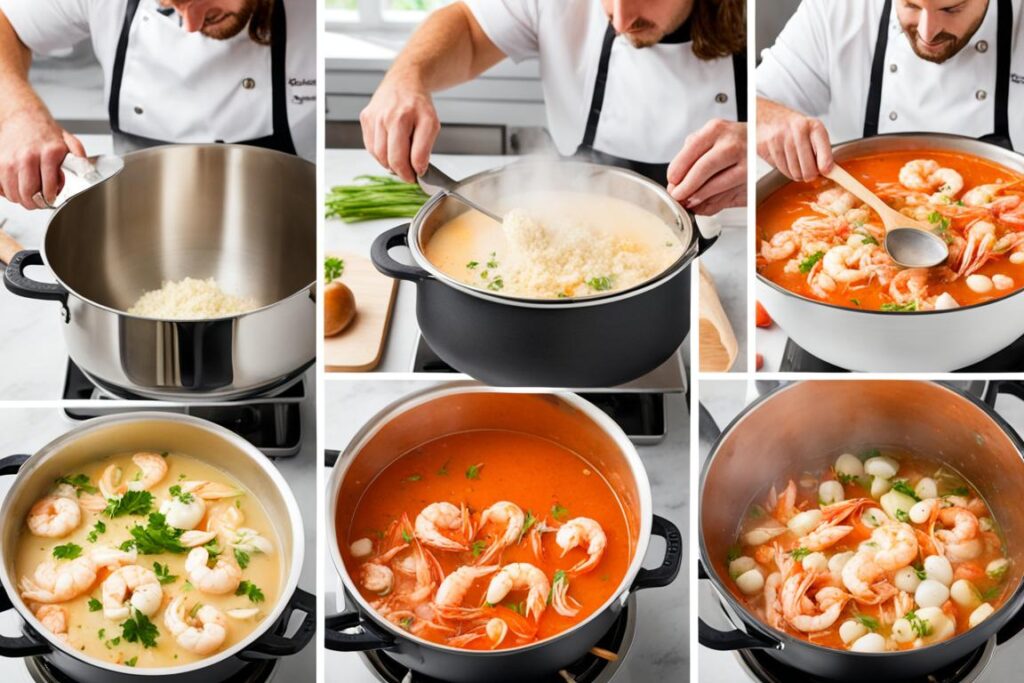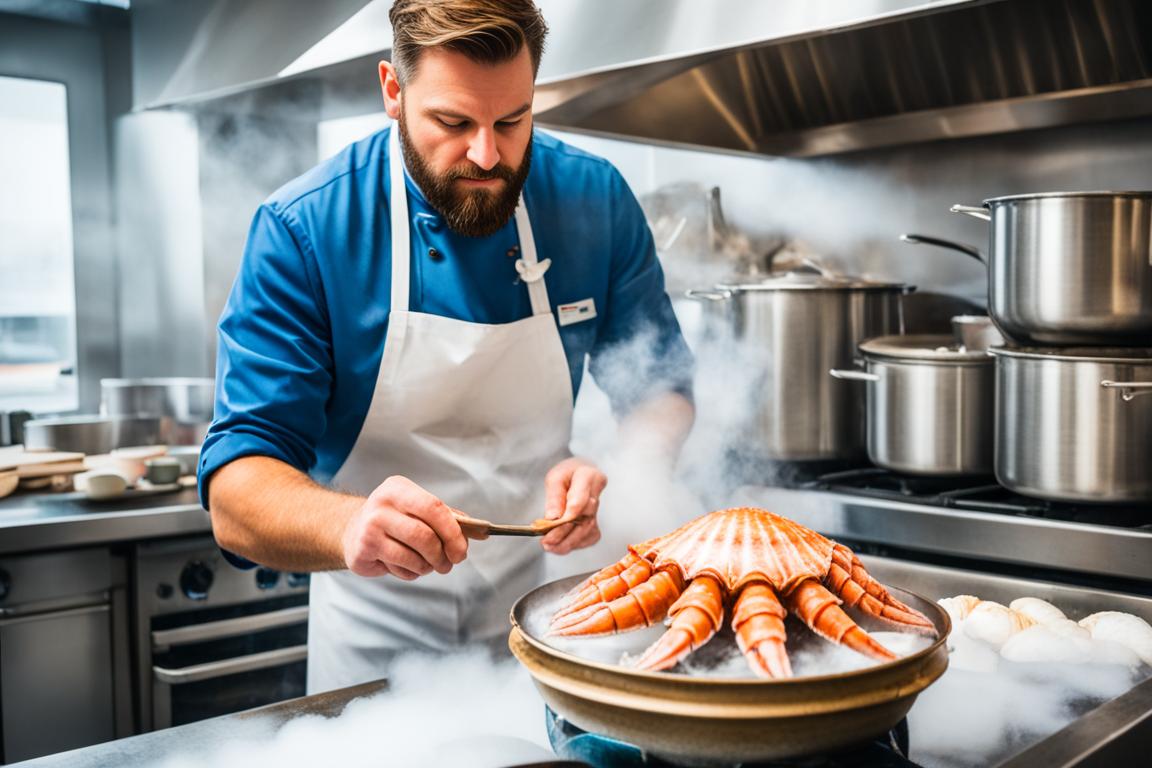Have you ever wondered why a dish is named a certain way? The name ‘bisque’ is more than just a label for a tasty soup. It has a rich history that connects it to pottery and craftsmanship. Let’s explore why it’s called bisque and what it means in both food and art.
Key Takeaways
- The term ‘bisque’ applies to both a type of pottery and a rich seafood soup.
- Its origins are linked to French and Latin, showcasing a cultural connection.
- Understanding ‘bisque’ provides insights into culinary terminology and usage.
- The question of why it’s called bisque invites deeper exploration of its evolution.
- Both culinary and artistic applications reflect the versatility of the term.
The Origin of the Term “Bisque”
The word “bisque” has a deep history tied to cooking. This tasty soup is mainly made with seafood. It shows its French bisque meaning as a term connected to certain places and cultures.
Exploring the French Connection
The bisque origin is closely linked to France, where it first appeared. The name comes from the Bay of Biscay, known for its rich sea life. French cooking often celebrates local ingredients, showing a love for the region.
This shows how the word’s use reflects French culture’s focus on local traditions.
The Latin Roots of Bisque
The word “bisque” comes from ‘biscoctus’, meaning ‘twice-cooked’. This method involves roasting the shells of seafood to boost flavor before cooking. This shows how the bisque meaning goes beyond just being a soup.
It highlights deep cooking traditions that have lasted over time. For more on its history, check out this resource.
Why is it called bisque?
The term bisque has a deep history in cooking. It started as “biscuit,” meaning hard, dry baked goods. Over time, “biscuit” in English changed to mean a softer, baked item. This change shows how cooking has changed across cultures, affecting flavors and textures.
Understanding the Transition from “Biscuit” to “Bisque”
The move from “biscuit” to bisque marks a new chapter in cooking. Why is it called bisque? It’s about new textures and ways of making food. Now, bisque is a creamy soup made from seafood broth. This change shows how language and food are closely linked.
This shift in naming gives us a peek into cooking history. As different cultures mixed, new ingredients and methods emerged. Today, chefs and home cooks keep the tradition alive, making bisque in new ways.
Bisque Ingredients: What Makes a Good Bisque?
A great bisque needs top-notch ingredients. For a seafood bisque, certain parts are key to a rich taste. Knowing these elements helps make a bisque that’s unforgettable.
Common Ingredients for Seafood Bisque
Quality crustaceans like lobster, crab, and shrimp are the base of a tasty seafood bisque. They add deep flavors and a luxurious feel. Onions, garlic, and celery add a fragrant base. Rice is often used to thicken the soup, making it more enjoyable to eat. Together, these ingredients create a mix of flavors that takes the dish to the next level.
Vegetable Bisque Variations
Bisque isn’t just for seafood. You can also make it with vegetables. Using roasted squash, tomatoes, and red peppers, you can create a creamy bisque. This method gives a rich texture similar to seafood bisque. It lets cooks make a dish that suits different diets while keeping the bisque style alive.

| Type of Bisque | Main Ingredients | Texture | Flavor Profile |
|---|---|---|---|
| Seafood Bisque | Lobster, crab, shrimp, rice, aromatic vegetables | Rich and creamy | Savory and deep |
| Vegetable Bisque | Squash, tomatoes, red peppers, garlic, onion | Creamy and smooth | Fruity and earthy |
The History of Bisque as a Culinary Dish
The history of bisque is a captivating story of culinary art. It takes us from its beginnings to today’s versions. Early recipes show off complex flavors and highlight the cultural importance of French cuisine in the 1700s.
Early Recipes and Cultural Influence
The first bisque recipes appeared in the 1700s in France. These historical recipes were all about careful preparation. They used local seafood and had rich, creamy textures. Bisque was a key dish in French cuisine, known for its gourmet look and use of local ingredients.
Evolution Through the Centuries
Over the years, bisque has changed with culinary trends and techniques. What started as a simple dish is now a fancy soup in upscale restaurants. Modern chefs have made it their own by adding new ingredients and methods. This shows how food culture changes and how bisque remains popular in different settings. For more about bisque, check out this link.
Creamy Bisque vs. Traditional Bisque
The world of bisque is full of flavors and textures. Knowing the difference between creamy and traditional bisque can make cooking more exciting. Creamy bisque uses a lot of cream, making it rich and smooth. Traditional bisque focuses on the natural taste of shellfish, giving it bold flavors.
Differentiating Ingredients and Preparation
To make creamy bisque, start with aromatic vegetables and add cream for a smooth texture. Traditional bisque needs a special method. It uses the shells of crustaceans to get deep flavors. This is key for its strong taste.
Regional Variations in Bisque
Looking into bisque styles shows many regional twists. In the U.S., chefs might add sherry or local ingredients. Other places use unique spices or seafood, showing how culture changes bisque.
| Type of Bisque | Main Ingredients | Preparation Method | Regional Variations |
|---|---|---|---|
| Creamy Bisque | Cream, vegetables, shellfish | Blend and simmer | Sherry-infused variants in the U.S. |
| Traditional Bisque | Shellfish, mirepoix, spices | Simmer shells for flavor infusion | Local seafood adaption globally |
For more info on classic bisque ingredients, check out this resource. Knowing these details helps food lovers enjoy the unique tastes in each bisque.
The Making of Seafood Bisque
Making a delicious crab bisque takes careful attention to detail. The key to its rich flavor comes from the meat and the shells of crustaceans. If you treat the shells right, they add a lot to the taste and depth of the bisque.
The Importance of Crustacean Shells in Flavor Extraction
To make a real seafood bisque, start by toasting the crustacean shells. This makes the shells release oils and brings out their natural flavors. Then, simmer them in the broth to create a strong base for the dish.
Cooking Techniques for Authenticity
For a true bisque, simmer the ingredients for a long time. This lets the flavors blend together perfectly. You can get a smooth texture by using a food mill or a fine strainer. Choosing top-quality ingredients is also key to making sure each spoonful tastes like the sea.

| Technique | Description | Benefits |
|---|---|---|
| Toasting Shells | Caramelizing crustacean shells to enhance flavor | Intensifies umami, improves depth |
| Extended Simmering | Cooking the broth for a longer time | Allows for robust flavor development |
| Straining | Using a food mill or strainer for texture | Achieves a creamy, smooth consistency |
| Quality Ingredients | Utilizing fresh seafood and premium stock | Enhances overall taste and satisfaction |
Bisque in Modern Cuisine
In today’s kitchens, modern bisque is a beloved dish. It’s known for its rich taste and smooth texture. Chefs love it for making popular dishes that food lovers enjoy. One classic favorite is lobster bisque, found in fancy restaurants.
Chefs are now adding new twists to bisque. They’re making spicy crab bisque and roasted mushroom bisque. These new flavors show how bisque is evolving with bisque trends and a desire for unique tastes.
There’s a big increase in cream-based soups lately, thanks to bisque. Chefs are mixing old flavors with new cooking methods. This creates soups that are both comforting and fancy.
This trend shows how bisque is changing the way we see comfort food. It’s becoming a key part of modern dining, offering a new kind of luxury.
Common Misconceptions About Bisque
Many people love bisque, but there are wrong ideas about it. Some think bisque is just any creamy soup. But, a true bisque is special because it comes from crustaceans and their shells. Knowing this is key for those who love cooking and food terms.
Distinguishing Between Bisque and Other Soups
Bisque is not just about the creamy texture. Unlike other soups, it focuses on crustaceans. Making a bisque means simmering shells to get a deep flavor. This makes bisque unique and worth understanding.
Clarifying Terminology in Culinary Context
Terms in cooking can be confusing, especially with bisque. It’s often mixed up with other creamy soups. By defining bisque clearly, chefs keep its traditional taste alive. This helps everyone appreciate and cook bisque right.
Conclusion
The name ‘bisque’ comes from French roots and is full of history. It shows us the deep culture and traditions behind it. This article has given readers a peek into the evolution of the culinary arts through bisque.
Exploring why it’s called bisque helps us see it as more than just a tasty dish. It’s a key part of our food heritage. The article cleared up some common misunderstandings about bisque, helping fans appreciate it more.
Understanding bisque’s many sides is key for food lovers. It’s important whether you stick to the classic recipe or try new twists. Exploring different fillings, like those in tortellini, is a great way to discover more about food. For more on tortellini fillings, check out this link here.


